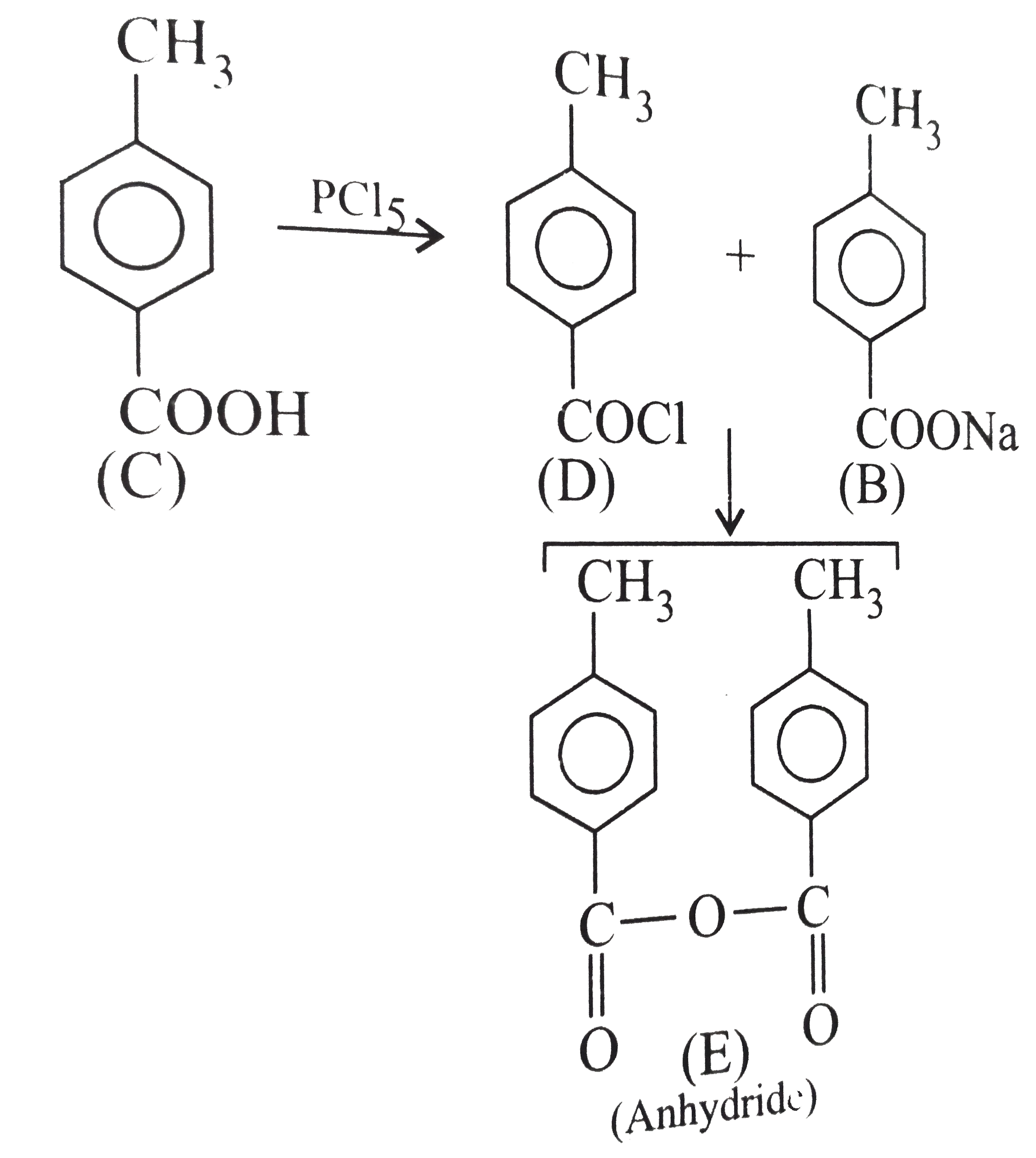The percentage of carbon, hydrogen, and nitrogen in an disibstituted aromatic compound (A) is 71.11,6.67, and 10.34, respectively. It molecule contains a single atom of nitrogen. Compound (A) evolves NH3 when heated with NaOH to form a salt (B) from which an acid (C) is obtained on acidification. If an electrophilic substitution is carried on (C), a leaving electrophile can occupy either of the two identical positions available in the ring. Acid (C) on heating with PCl5 gives (D) which reacts with (B) to give an organic product (E). Give the structures of (A) to (E) with proper reasoning.
(i) Simplest ratioC=71.1 %,71.1112=5.925.920.74=8H= 6.67 %,6.671=6.676.670.74=9N=10.37 %,10.3714=0.740.740.74=1O=11.85%,11.8516=0.740.740.74=1
The empiricial formula of (A)=C8H9NO
A⇒ contains only one N atom in its molecule and thus the molecular formula of (A)=C8H9NO.
(ii) ⎛⎜
⎜⎝−O∣∣C−NH2⎞⎟
⎟⎠
(iii) 
(iv) 
(v) SE reaction on (C) gives one product and thus (C) is para derivative and (A) and (B) are para derivatives.
Reactions :

Topper's Solved these Questions
- CARBOXYLIC ACIDS AND THEIR DERIVATIVESBOOK - CENGAGE CHEMISTRYCHAPTER - CARBOXYLIC ACIDS AND THEIR DERIVATIVESEXERCISE - Exercises (Linked Comprehension)
34 Videos
- CARBOXYLIC ACIDS AND THEIR DERIVATIVESBOOK - CENGAGE CHEMISTRYCHAPTER - CARBOXYLIC ACIDS AND THEIR DERIVATIVESEXERCISE - Exercises (Multiple Correct)
35 Videos
- CARBOXYLIC ACIDS AND THEIR DERIVATIVESBOOK - CENGAGE CHEMISTRYCHAPTER - CARBOXYLIC ACIDS AND THEIR DERIVATIVESEXERCISE - Solved Examples
17 Videos
- BIOMOLECULES, POLYMERS AND CHEMISTRY IN EVERYDAY LIFEBOOK - CENGAGE CHEMISTRYCHAPTER - BIOMOLECULES, POLYMERS AND CHEMISTRY IN EVERYDAY LIFEEXERCISE - QUESTION BANK
8 Videos
- CHEMICAL KINETICSBOOK - CENGAGE CHEMISTRYCHAPTER - CHEMICAL KINETICSEXERCISE - Archives Subjective
23 Videos
Similar Questions
The perentage of C, H, N in a disubtituted aromatic compound (A) is 71.11 , 6.67 and 10.37 respectively . Its molecule contains a single atom of nitrogen . Compound (A) gives NH3 when heated with NaOH to from a salt (B) form which an acid (C) is obtained on acidifcations. Two isomers are generated when (C) undergoes electrophilic aromatic substitution. (C) on treatement with PCl5 generates (D) which on reaction with (B) generates (E) . Identify (A) to (E).
View SolutionSeAr (Electrophilic Aromatic Substitution)
View Solution
Knowledge Check
For an electrophilic aromatic substitution reaction
AChlorine is o-p directing group and also electron releasing groupBChlorine is o-p directing group and also electron withdrawing groupCChlorine is meta directing group and also electron releasing groupDChlorine is meta directing group and also electron withdrawing groupElectrophilic aromatic substitution is difficult in
Ap−NH2C6H4CO2HBp−CH3OC6H4CO2HCP−NO2−C6H4CO2HDp−ClC6H4CO2HAromatic electrophilic substitution reaction that is reversible is
AnitrationBchlorinationCsulphonationDalkylation
Introduction OF Electrophilic Aromatic Substitution Reaction
View SolutionAromatic electrophilic substitution with iodine can be carried out using......
View SolutionCinnamic acid towards electrophilic aromatic substitution
View SolutionThe electrophilic aromatic substitution proceeds through a:
View SolutionWhich of the following reaction belong to electrophilic aromatic substitution
View Solution
